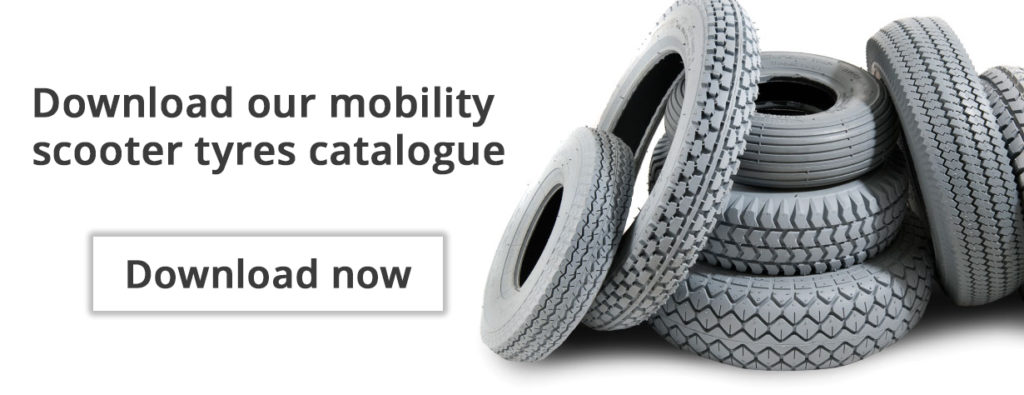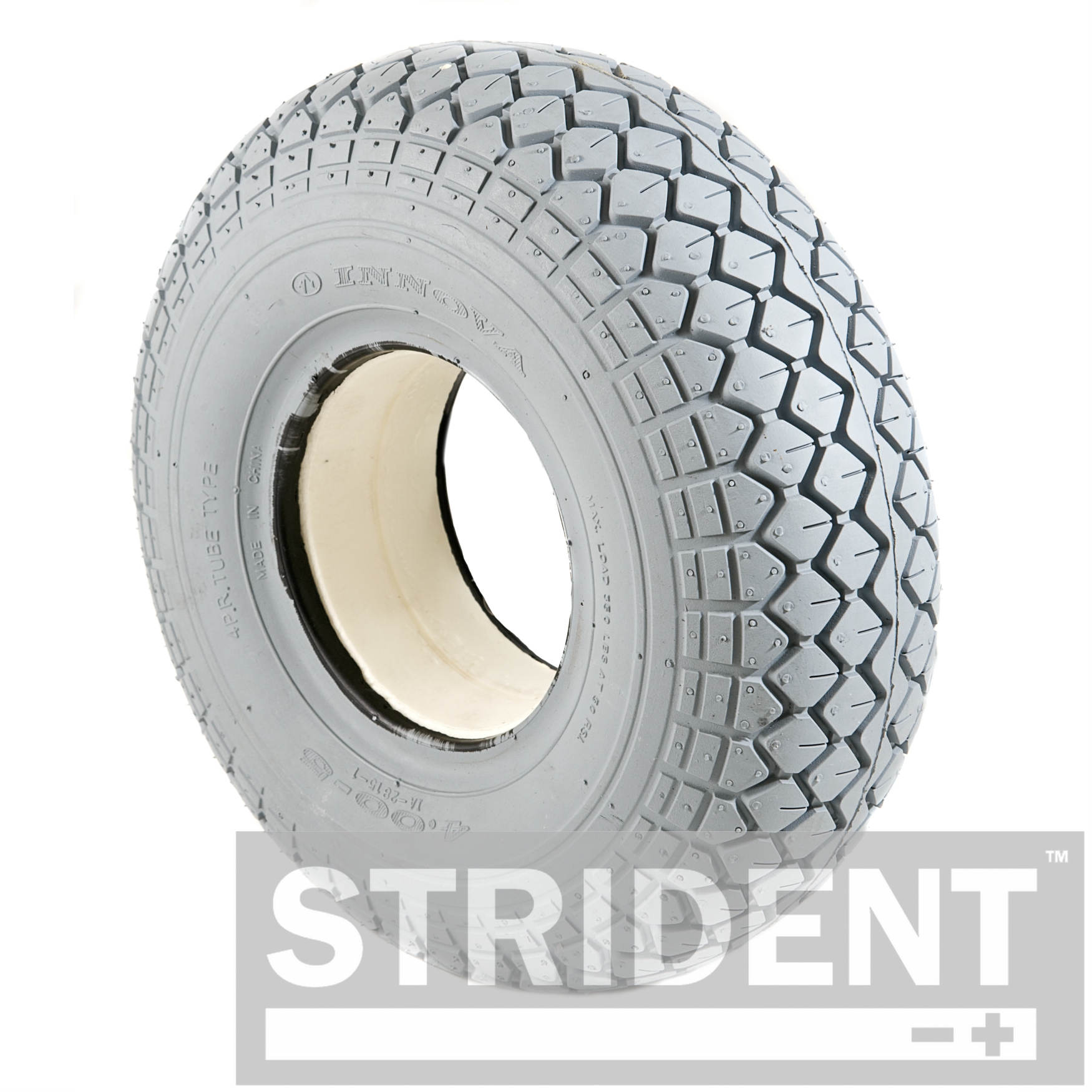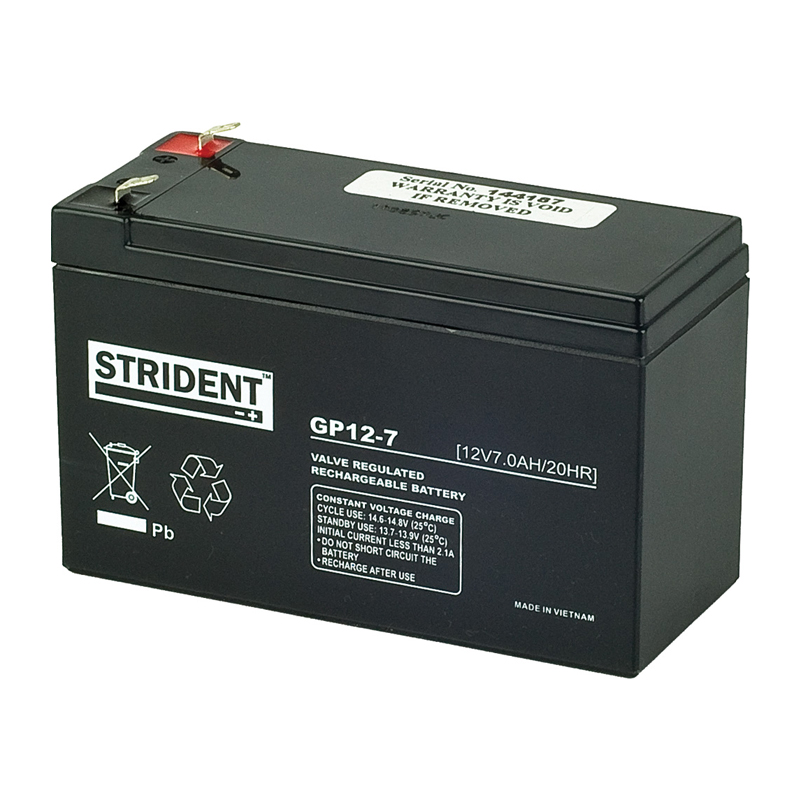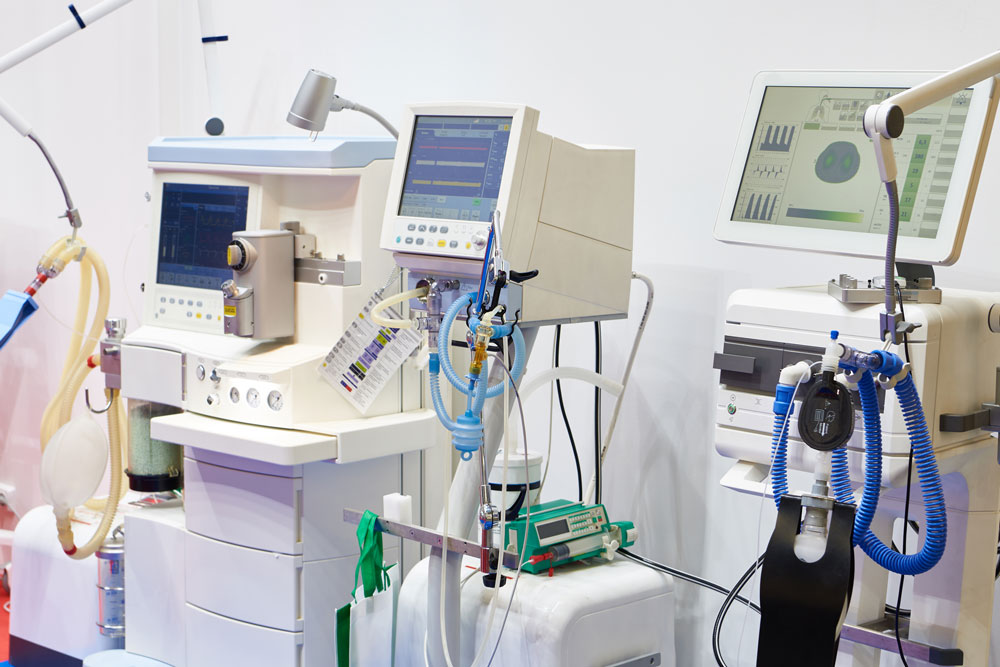Air vs Solid tyres for mobility scooters - choosing what’s best for each type of user

As most will know, there are two main types of mobility scooter tyres, air (pneumatic) and solid. In this blog, we’ll be looking at the key differences between the two and how that helps to know which of the two is best for each user of mobility scooters.
What directs the choice between air or solid tyres for mobility scooters?
When it comes down to it, the choice between air or solid tyres is all down to the pattern of use and the user themselves. While a small number of mobility scooter brands only support one type of tyre, for the most part, there will be an option on what to use.
How to know what type of tyre is best for a mobility scooter user
There are lots of differences between air and solid tyres, but it’s usually quite easy to understand what the best for is for each person.
- The quality of the ride -Air tyres provide a much smoother ride than solid tyres; this is due to the natural shock absorption that you get from air tyres. Solid tyres for mobility scooters have reduced natural shock absorption so the ride will be a little bumpier.
- Durability -Solid tyres tend to be more durable and last longer than air tyres. This is because there are a lot fewer variables that can affect your tyres. For instance, you can’t under- or over-inflate solid tyres, and you’re not at risk of punctures with solid tyres.
- The combined weight of the mobility scooter and user -Some mobility scooters are surprisingly heavy and, when combined with the weight of the user, this will have an impact on the longevity of your tyres. Weight tends to impact solid tyres and can damage them more than a high-quality pneumatic tyre.
- What terrain you’re travelling on - The terrain driven on is one of the biggest factors that will help decide on whether air or solid mobility scooter tyres are best. If the user lives in town then surfaces tend to be smooth, and air tyres are fine. If the user travels across rough ground, like gravel surfaces, or where there may be glass in public areas, a solid tyre may be the better choice.
- Price -Air tyres are cheaper than solid mobility scooter tyres. However, as some of the points above highlight, it may not always be best to opt for the cheaper option, e.g. the cost of repairing 2-3 punctures would outweigh the cost saving made on an air tyre.
Summary of what each tyre is best for
Air mobility scooter tyres are best suited to smooth, tarmacked surfaces, where there is minimal risk of tyre damage. On smooth, flat, surfaces, air tyres will offer a more comfortable ride and can provide longer ranges due to less tyre friction.
Solid tyres for mobility scooters are a must for recreational users. If a mobility scooter is often on gravel paths and in rural areas, then air tyres will carry a risk of a puncture. Also, solid tyres for mobility scooters tend to have more friction on the surface so in rural areas you will have better grip.
What can happen if you choose the wrong type of tyre?
If you happen to choose the type of tyre that's not best suited to your needs, then you will either be decreasing the potential lifespan of your tyres or may not be maximising the overall performance of your mobility scooter.
Here’s an example to show you what kind of impact that choosing the wrong type of tyre can have.
A regular pub-goer opted for air tyres on his mobility scooter, without actually thinking of the potential risks that are in and around a pub… the main one being broken glass! As a result, the owner kept getting punctures. If the user had opted for solid tyres, in the beginning, there would have been no risk of a puncture. So do choose wisely!
If you’re struggling to decide what tyres are best for a particular type of mobility scooter or a specific pattern of use, we would be happy to talk you through the choices and find out what is best.
If you’re looking to source good quality air and solid tyres, then make sure you look at our Strident tyre brochure.

12v 7ah Battery Product Review – for Mobility Applications
If you are looking for a 12v 7ah rated AGM Battery for use with a Mobility Scooter or Medical Hoist, then here is a review of the Strident Batteries AGM GP12-7. This is one of the best selling batteries in the Strident range and recognised by mobility and disability equipment installers and maintenance companies for some industry leading features.
But all 12 volt batteries are the same…aren’t they?
What is the purpose of a review if every battery is the same? Well, if you consider that these standard valve regulated lead acid rechargeable batteries were first launched in the 1970’s, you won’t be surprised that there design and performance has evolved somewhat since then.
What does a 12 volt rechargeable battery need to offer in a mobility or medical setting?
There are 3 main factors that feature in the requirements for mobility and medical batteries:
1. The ability to sustain high demands of constant use
2. Being able to perform a high number of operational cycles
3. Trust from dependent users that it will perform when and where it is needed
How does Strident’s 12v 7ah battery meet those requirements?

- Valve Regulated. The performance of the valve equipment is to key to the effectiveness and longevity of a battery – particularly when it comes to charging. Strident use the highest specification for optimal venting.
- Quality Control. A stringent testing procedure at both point of manufacture and point of despatch is essential. The second check is as crucial as the first and so Strident test each battery going out of its automated central warehouse.
- Plate Separator. All high performing batteries need to have a plate separator system for increased efficiency and longevity. Strident use a superior quality glass matting separator in all AGM batteries and high performing polymer in Gel battery range.
- Plate Composition. To give maximum performance during both cyclic and standby applications, Strident use a purified lead blended with critical conductive properties.
Strident Service on top of the technology
If the technical review of our 12v 7ah battery is not enough information, then we can also share this review of the whole Strident experience from a recent customer.
I chose this mobility battery for 3 reasons. Reasonably priced, fast delivery (also here when they were meant to be), and finally – VERY good quality! No problems with recharging them and they are fully charged in about 3 hours.
Thanks so very much.
AS June 2016
Please visit our Product page for details and enquiries or in order to arrange a callback.
What Makes a Quality Valve Regulated Lead Acid Battery?
When looking to purchase a power supply for vital (or even life-critical) equipment, quality and reliability are essential characteristics to look out for. But with so many choices on the market, it can be difficult to differentiate between a quality product and a potentially inferior one.
So how exactly do you identify a quality valve regulated lead acid battery?
While there’s no one-size-fits-all solution to every type of power requirement, there are specific features to look out for which provide an excellent idea of where to start.

Valve Regulation
Valve regulated batteries allow the required level of venting, both in-use and more importantly during the charging process. This means excess gases can safely escape the battery, preventing swelling and damage to the product. Valve regulation is key to both Lead Acid and Gel technology, however, due the nature of the technology, venting is most critical with Lead Acid.
Plate Separators
A critical component of high performing batteries - plate separators ensure consistent spacing between plates, resulting in increased battery efficiency and longevity. Lead acid technology requires high-quality absorbent glass matting otherwise known as AGM. The quality of this matting is important to ensure correct porosity, which influences the contact of active electrolyte to the plates. Purity is another important factor in the separator to ensure no contaminants are introduced causing impedance to the battery efficiency.
In the case of Gel technology, the separator needs to be a high performing polymer which acts to retain the gelled electrolyte between plates. A poor quality polymer separator can result in crystallisation of the electrolyte leading to underperforming battery and premature failure.
Plate Composition
Purified lead, specifically blended with critical conductive properties are essential to quality performance in both cyclic and standby applications.
Quality Assurance
To ensure the highest performing products, there are a number of internationally respected standards that you should look for on any brand. The minimum level would be ISO9001 which monitors consistent quality. ISO14001 ensure the manufacturing facility operates to highest level of environmental standards.
All Strident batteries undergo stringent quality control both at the manufacture stage and pre-dispatch. This ensures our customers only draw the most reliable source of power. Be sure to ask your supplier about their quality assurance process for complete peace of mind.

For over 15 years Strident has invested large amounts of time and money in research, development and innovation in battery power, to ensure our products are suited to the high demands of the medical sector, demands that will sustain deep discharge and cyclic applications.
Our team have gained a vast knowledge of the requirements in the medical market and are always happy to assist with any queries you may have
You can contact us by phone on +44 (0)1362 300102, email us at sales@strident.uk.com, or reach us via our contact page, and we can arrange an inspiring presentation at a location and time that’s convenient to you.
For more information on our products, including batteries, charging accessories, and tyres, you can download one of our brochures, here.
Mobility and Medical - the Best Battery Types
At Strident, we specialise in batteries for a range of applications in the medical market.
From mobility scooters to power chairs and life-critical support, it’s essential that we supply the right type of battery to meet our customer’s specific needs. So what’s the best type of battery to use with these devices, and why?

Most devices like these rely on either AGM (absorbent glass mat) or GEL batteries. The chief benefit of these battery types is that they’re sealed, and therefore unlike some older types of lead acid batteries, are maintenance free and won’t spill or leak when installed under normal operating conditions.
As well as being very low maintenance, these battery types are also ideal for repeat cycling and daily use. Which in the context of mobility devices, is an absolute must. Furthermore, their limiting design results in a much longer cycle life than conventional lead acid equivalents.
Between the two, AGM batteries tend to be cheaper than their equivalent power GEL types. However, GEL batteries boast a greater expected lifespan. As a general rule though, you should always use the battery technology that’s recommended by the manufacturer for your mobility device. Some manufacturers even offer upgrade packages to enable differing technologies to be used.
If you’re unsure as to what the best battery types are for your product or application, get in touch with the knowledgeable team here at Strident.
With over 15 years of direct experience with battery power, our expert staff are happy to help you make an informed decision.
You can get in touch with us directly on 01326 300 102, or message us via the contact page. For more information on our products, including charging accessories, you can download one of our brochures, here.
GEL Batteries – Continuing to Innovate
It’s sometimes strange to think that products as everyday as batteries could still be being innovated and improved upon. But ever since their conception in the 1800’s, battery technologies have evolved tremendously, and are continuing to do so.
Here at Strident, we’re always working on our battery technology in order to deliver the finest service and greatest reliability to our customers.

One of our most popular types of product is our line of GEL batteries, as these are used in a variety of applications - from mobility scooters to life critical support units.
So how are Strident GEL batteries innovating, and making themselves attractive alternatives to conventional sealed lead-acid technology?
- The Strident range of GEL batteries is designed to resist deep discharges and recovery after heavy usage, even when they’re not recharged immediately
- They provide excellent performance over long discharges
- They boast outstanding tolerance to higher temperature applications (-25 - +55C)
- Their limiting design protects the positive plates to greatly improve their cycle life
- They can be discharged even when full recharge has not been achieved, without loss of battery capacity
- They use thicker plates for reduced grid corrosion and increased cycle life
- They also boast an extended shelf life, and are designed to last for over ten years
Our GEL batteries are even tried and tested in rugged environments, in order gauge their performance in extreme circumstances.
Here at Strident, these are just one of the product types we’re continuing to improve every day.
If you think GEL batteries might be the perfect choice for your application, don’t hesitate to get in touch with the team here at Strident. With over 15 years of direct experience with battery power, our knowledgeable staff are happy to help you make an informed decision.
You can get in touch with us directly on 0845 555 5511, or message us via the contact page. For more information on our products, including our selection of innovative battery types, you can download one of our brochures here.
Storing Batteries - Our Top Tips
Depending on your specific needs, you may not use your batteries on a daily basis. In which case, the issue of how best to store them becomes very important.
So what exactly is the best way to effectively store your batteries? The answer really depends on the product’s type, or chemistry.
The recommended temperature to store most battery types at, is around 15°C.
At extreme temperatures, they can be stored at a minimum of -40°C, and a maximum of 50°C. There are more important considerations other than just temperature however.

For example, lead acid batteries should always be kept fully charged during storage. But nickel and lithium based chemistries should be stored at around 40% of their maximum capacities. This is in order to reduce any potential capacity loss, while still ensuing the battery runs optimally.
Bear the following points in mind when storing batteries for any length of time:
• Before storing your batteries, remove them from any equipment they might be attached to, and ensure they’re placed in a cool, dry area.
• Make sure they’re not likely to freeze over. Remember that they will freeze more easily if they’ve been drained.
• Lead acid batteries should be charged before storing, and you should regularly check their charge levels.
• Nickel batteries can be safely stored for up to five years with no charge in them if necessary.
• Lithium-ion batteries should be stored at around 40% capacity.
• Remember to keep all battery products out of reach of children.

For additional tips on battery storage, or for advice on purchasing new batteries, don’t hesitate to ask the team here at Ivanhoe.
With over 15 years of direct experience with battery power, our knowledgeable team is happy to help you make an informed decision.
You can get in touch with us directly on 0845 555 5511, or message us via the contact page. For more information on any of our products, please download one of our brochures.
Choosing the Best Battery Charger
Identifying the right type of battery for your device is usually a straightforward process. User manuals and manufacturer information tend to recommend a particular type and voltage. But when it comes to choosing a quality battery charger, there’s often a greater selection and a bit less direction.
Using a quality charger will ensure your batteries are being effectively conditioned and maintained. So what are the essential steps to choosing the best battery charger?
- Firstly, pick a charger that’s intended for your battery’s chemistry i.e. lead acid, gel, AGM, etc. and make sure that the battery voltage matches that of the charger.
- If you’re looking for a high wattage charger, remember that these shorten charge times, but there are limitations as to how fast a battery can be charged, and fast charging can cause stress.
- If you’re looking for a lead acid charger, check that it switches to a float charge when fully saturated.
- If you need a nickel-based charger, check that it switches to a trickle charge when full.
- Regardless of your battery type, check that your charger has a temperature override to end charge on a faulty battery.
Here at Ivanhoe, our range of battery chargers cover 12 and 24v applications, including bench chargers with crocodile clip and 3-pin XLR connectors. Their intelligent systems work through three charging stages to ensure maximum battery efficiency and longevity.
The stages begin with a bulk charge - where the charging current is set to the maximum safety level, and charges to 80 – 90% of the battery’s full charge level.
This is then followed by an absorption charge – where the charging voltage remains constant and the current reduces due to the increase in internal resistance.
The process finishes with a float charge – where once the battery has reached optimum charge level, the charging voltage and current is significantly reduced. This helps to increase the longevity of the battery.
With this intelligent three-stage charging technique, premature battery failure is significantly reduced, as the correct levels of charge are applied at every stage of the process. This also eliminates risk of gassing often caused by overcharging in traditional single-stage charging.
With over 15 years of direct experience with battery power, our knowledgeable team is happy to assist in choosing the best battery charger for your product.
If you’d like any assistance in finding a reliable, long-lasting charger, get in touch with us today on 0845 555 5511 or message us via the contact page.
Batteries for the Medical Sector
You might be surprised at just how many different battery types are used in a modern hospital. Between heart-rate monitors, respirators, comms devices and pacemakers, there’s an essential need for different battery types throughout the medical sector.
But the most commonly used batteries for life-critical medical applications are SLAs or ‘Sealed Lead Acid’ batteries. Contained in plastic casing, these are perfect for backing up equipment like emergency lighting and ventilators.
But why are SLAs right for such important applications?
Characteristics of Batteries for the Medical Sector
First seen in the 1970’s, SLA batteries were designed with a built-in valve to control venting of gases during stressful charge and rapid discharge. Rather than submerging the battery plates in a liquid (like most others at the time), the electrolyte is fed into a moistened separator, enabling use of the battery in any position without it leaking.
Perhaps the most significant advantage of sealed lead acid is its ability to prevent water loss. It does this by combining oxygen and hydrogen internally; creating water and greatly increasing its own longevity.
Over time, several types of sealed lead acid batteries have emerged - the fastest growing being gel (also known as valve-regulated lead acid/VRLA) and absorbent glass mat (or AGM.) Because of their low cost, reliability and low maintenance requirement, these battery types have established themselves as the default choice for the medical sector.
While VRLAs remains the most requested batteries on the market today, the technology has evolved rapidly through proactive research and development.
Here at Strident we offer a range of batteries for the medical sector, such as Gel and Lithium. We also stock a range of lead crystal batteries, that hold many unique features suited to any critical power application.
With over 15 years of direct experience with battery power, our knowledgeable team is happy to assist in choosing a reliable, long-lasting product.
If you work in a medical environment that uses batteries for life-critical applications; get in touch with us today on 0845 555 5511 or message us via the contact page.







